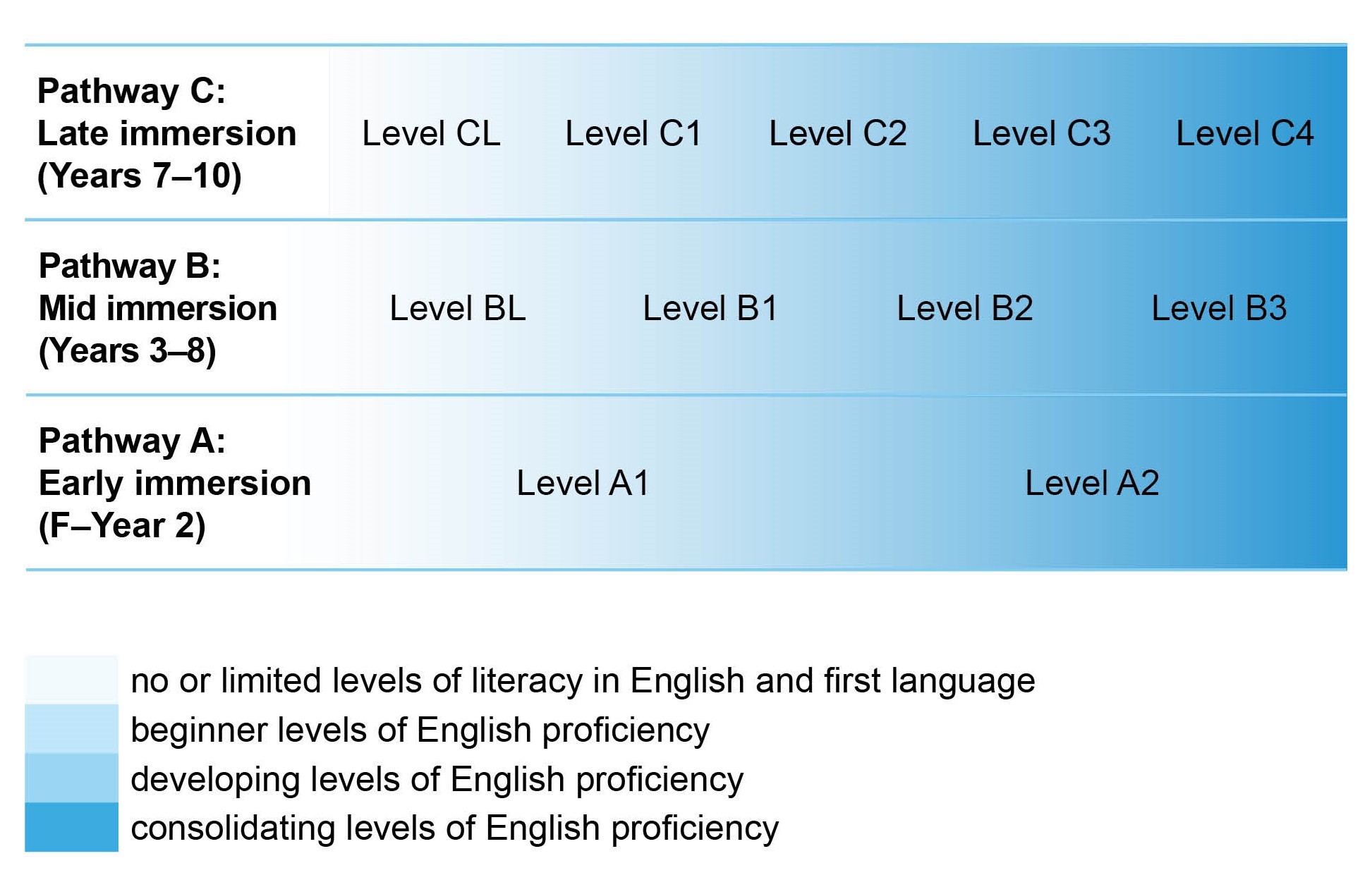The English as an Additional Language (EAL) curriculum is organised by pathways, language modes and strands.
The EAL curriculum is a continuum structured as three EAL pathways (A, B, C). Each pathway describes a different stage of English-language learning (early, mid and late), and each pathway is divided into different levels of language learning (A1, A2, BL, B1, B2, B3, CL, C1, C2, C3, C4).
Early immersion language learners typically develop their literacy skills through experiences in the school context. Those who have had some experience of formal preschool or school will more readily adapt to the school setting.
A student located on EAL Pathway A may have some experience of formal learning in their home language or other languages and some experience of informal prior learning.
EAL Pathway A includes two levels of English-language learning: Level A1 and Level A2. Those with little or no experience of English begin at A1; those with some experience may begin at A2. The progress within these levels equates to the rates of progression expected in Foundation–Year 2.
Generally students who enter Foundation are pre-literate, regardless of their language background, and hence there is no Level AL. EAL students who enter Foundation with minimal literacy in other languages will begin their early immersion in English at Level A1.
Mid immersion language learners have experience of the social use of language, which they can use as they learn English at school. A student located on EAL Pathway B may have some experience of informal learning in their home language or other languages. Some have yet to experience formal schooling, while others may have experienced formal learning that is equivalent to their English-speaking peers. This may have been in their home language or other languages.
EAL learners with little or no English proficiency, fewer than two years of formal learning and minimal home literacy experience will begin this pathway at Level BL, before moving to Level B1. Learners with prior experience of formal learning but no proficiency in English begin at Level B1, and move through Levels B1, B2 and B3. The progress within these levels equates to the rates of progression expected in Years 3–8.
Late immersion language learners have a mature understanding of themselves and their relations with others in different social contexts, and are capable of understanding abstract ideas and relationships in their experience and learning about the world.
EAL learners without prior formal learning and with minimal home language literacy experience will begin this pathway at Level CL, before moving to the other levels. Learners with prior experience of formal learning but no proficiency in English will begin on Level C1 and move through Levels C1, C2, C3 and C4. The progress within these levels equates to the rates of progression expected in Years 7–10.
Please note: The overlap in year level ranges allows for professional teacher judgement about the individual experiences and circumstances of each student when locating them on a particular pathway. Teacher discretion also determines the most appropriate point at which an individual student is ready to move from the EAL curriculum to the English curriculum. For more information, please refer to English as an additional language curriculum resource page.

The three language modes are the same as in the English curriculum.
| Language mode | Speaking and Listening | Reading and Viewing | Writing |
|---|---|---|---|
| Speaking and Listening refers to the various formal and informal ways spoken language is used to convey and receive meaning. It involves the development and demonstration of knowledge about the appropriate spoken language for particular audiences and occasions, including elements of presentation such as body language and use of voice. It also involves the development of aural skills such as active-listening strategies and an understanding of the conventions of different spoken texts. | Reading and Viewing involves students understanding, interpreting, critically analysing, reflecting upon, and enjoying print and digital texts, including visual, multimodal and interactive texts. It encompasses reading and viewing a wide range of text types, including informative and persuasive texts as well as texts that are appreciated for their artistic or entertainment value. Reading involves active engagement with texts and the development of knowledge about the relationship between the texts and the contexts in which they are created. It also involves the development of knowledge about a range of strategies for reading, to assist with comprehension and interpretation. | Writing involves students in the active process of conceiving, planning, creating, producing, editing and publishing a range of texts. Writing involves using appropriate language for particular purposes or circumstances, both formal and informal, to express and represent ideas and experiences, and to reflect on these ideas and experiences. It involves the development of knowledge about strategies for writing and the conventions of Standard Australian English. Students develop the metalanguage (language for talking about language) to discuss English language conventions and use. |
Within each language mode, the content descriptions are grouped into strands.
Communication focuses on communicating in spoken and written English for social and academic purposes, and the meanings that learners interpret and convey.
Cultural and plurilingual awareness focuses on understanding and using the cultural conventions of spoken and written communication in Standard Australian English – including the relationships between text and context, and audience and purpose – and drawing on the knowledge and resources of students’ other languages and cultures to negotiate communication and enhance learning.
Linguistic structures and features focuses on control over the structures and features of spoken and written English, at the levels of word, sentence and whole text. Linguistic structures and features of texts include an understanding of the genre, form and language conventions selected by authors to convey meaning.
In English as an Additional Language, students progress along a curriculum continuum structured as three EAL pathways. An achievement standard is provided at each level on each pathway.